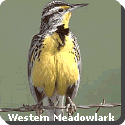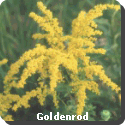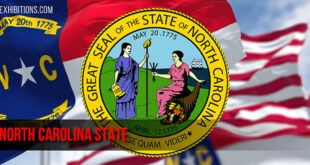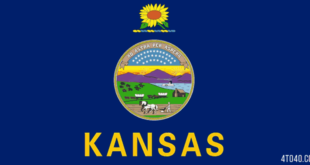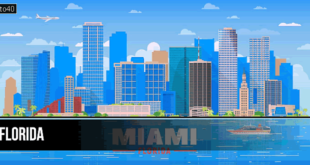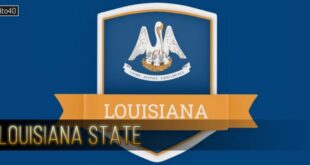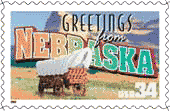 Nebraska lies immediately to the north of the geographic center of the conterminous United States, bounded on the north by South Dakota, on the west by Colorado and Wyoming, on the south by Kansas, and on the east by Iowa and Missouri. The extreme length of the state from south to north is 330 km (205 mi), and its extreme breadth from east to west is 727 km (452 mi). The total area of the state is 200,356 sq km (77,358 sq mi), making it the 16th largest of the 50 states.
Nebraska lies immediately to the north of the geographic center of the conterminous United States, bounded on the north by South Dakota, on the west by Colorado and Wyoming, on the south by Kansas, and on the east by Iowa and Missouri. The extreme length of the state from south to north is 330 km (205 mi), and its extreme breadth from east to west is 727 km (452 mi). The total area of the state is 200,356 sq km (77,358 sq mi), making it the 16th largest of the 50 states.
The name of Nebraska comes from the Oto Indian word nebrathka, which means “flat water,” referring to the Platte River. The nickname of “Tree Planters’ State” was selected by the legislature in 1895 in official recognition of the pioneers’ efforts in planting trees on the prairie. In 1945 the state’s official nickname was changed to “Cornhusker State” in honor of the University of Nebraska’s football team.
Land & Resources
 Nebraska lies within two major physiographic regions of North America, the central lowlands and the GREAT PLAINS. In the central lowlands and along the Missouri River elevations average about 255 m (840 ft), rising to about 365 m (1,200 ft) in the northeast. Elevations also increase westward to about 915 m (3,000 ft) in the southwest and to about 1,525 m (5,000 ft) in the northwest. The highest elevation in the state is 1,654 m (5,426 ft), in Kimball County.
Nebraska lies within two major physiographic regions of North America, the central lowlands and the GREAT PLAINS. In the central lowlands and along the Missouri River elevations average about 255 m (840 ft), rising to about 365 m (1,200 ft) in the northeast. Elevations also increase westward to about 915 m (3,000 ft) in the southwest and to about 1,525 m (5,000 ft) in the northwest. The highest elevation in the state is 1,654 m (5,426 ft), in Kimball County.
The topography changes from level to gently rolling prairie in the central lowlands. The eastern section of this area is a part of a glacial till plain that has been subjected to extensive weathering and erosion to form a well-developed drainage system. Farther west is the Sand Hill region, which occupies about 52,000 sq km (20,000 sq mi). It is characterized by sand dunes covered with short grasses and is interspersed with numerous valleys and shallow lakes. The High Plains section of the Great Plains lies to the west and south of the Sand Hills region.
Climate
Nebraska has light precipitation, relatively low humidity, hot summers, cold winters, and great variations in temperature and precipitation from year to year. Mean January temperatures are -5 deg C (23 deg F), with the coldest temperatures in the northeast, while the July mean temperature is 24 deg C (76 deg F), with the warmest temperatures in the southeast and south central sections. The growing season varies greatly from year to year and averages about 172 days in the southeast to about 122 days in the extreme northwest. The annual precipitation in the southeast averages 787 mm (31 in), in the central portion 584 mm (23 in), and in the panhandle 432 mm (17 in). About 77% of the precipitation falls during the months of April to September, with approximately 45% of the annual total from May through July.
Historical Sites
The Homestead National Monument of America, located about 65 km (40 mi) south of Lincoln, commemorates the first farm plot to be claimed under the HOMESTEAD ACT of 1862. Chimney Rock National Historic Site and Scotts Bluff National Monument are important landmarks along the Overland Trail. Fort Robinson State Historical Park commemorates what was once an important military post during the Indian wars; CRAZY HORSE, chief of the Sioux, was killed there.
Transportation and Tourism
The central location of Nebraska and the national road network that crosses it have facilitated tourism in the state. Omaha is an important rail center with several railroads and is a regional hub of air transportation. Omaha’s Eppley Airfield is the state’s busiest airport.
Nebraska has numerous state parks and recreation areas. Most tourists visit Nebraska while on their way to either eastern or western parts of the country.
History
Archaeological explorations and excavations indicate the presence of prehistoric humans in Nebraska as early as 9000 BC. The PAWNEE Indian tribe was one of the first groups to be recorded in the area. Other Indian groups found by European explorers were the ARAPAHO, CHEYENNE, OMAHA, OTO, and SIOUX. With the introduction of the horse by the Spanish, buffalo hunting supplemented the primitive crop agriculture of pre-European times. It is estimated that the Indian population numbered about 40,000 at the time of the earliest white settlement.
Pedro de Villasur and a party of Spanish soldiers were the first Europeans known to have reached Nebraska (1720), though some French fur traders and trappers had ventured upstream on the Missouri River by about 1700. The first Europeans to cross the state were probably Paul and Pierre Mallet, who traversed nearly the entire length of the modern state in their journey from the Missouri to Santa Fe, New Mexico, in 1739.
Spain, France, and Great Britain struggled for possession of the Nebraska region, basing their claims on discoveries and explorations. France ceded all claims west of the Mississippi River to Spain in 1763, at the close of the Seven Years’ War. Nebraska remained part of Spain until 1801, when Napoleon purchased the area for France. In 1803, Thomas Jefferson acquired the Louisiana Territory, which included present-day Nebraska, for the United States.
After the LOUISIANA PURCHASE President Jefferson requested that a geographical expedition of the area be undertaken. The LEWIS AND CLARK EXPEDITION crossed the eastern edge of what was to become Nebraska. Journals of the expedition were perhaps the first authoritative sources of geographic information about the state. Later expeditions led by Zebulon Montgomery PIKE (1806) and Stephen H. LONG (1820) furnished additional information about the region. It is generally acknowledged that Long’s report was responsible for the questionable image of the area west of the Missouri River, describing it as unfit for cultivation and part of the “Great American Desert.” Because of the unfavorable desert image, the Great Plains were at first passed by in favor of settlement areas farther west.
Numerous traders, trappers, missionaries, and travelers moved across the state between 1800 and 1840. The famous OREGON TRAIL followed the Little Blue and Platte rivers through Nebraska and was used by thousands of wagon trains from 1830 to 1870. The Mormon Trail to Utah and the Denver Trail to Colorado also crossed the area. From 1850 to 1860 steamboat navigation on the Missouri River was at its peak, only to fall off with the advent of rail travel in the 1860s.
Nebraska was part of the Territory of Indiana from Oct. 1, 1804, to July 4, 1805. From that time until Dec. 7, 1812, it was part of the Louisiana Territory. It then became part of the Territory of Missouri until 1821, when Missouri became a state and Nebraska part of an unorganized region usually called “Indian country.” On June 30, 1834, the U.S. Congress defined the boundaries of this Indian country and passed the Indian Intercourse Act, which excluded white settlers and formalized relations between the United States and the Indians. The Indian superintendent at St. Louis was made governor of the area. The first congressional bill organizing the territory, the KANSAS-NEBRASKA ACT, was passed in 1854, and the first session of the territorial legislature met Jan. 16, 1855. Shortly after the Civil War the population of Nebraska and the Great Plains began to grow rapidly, from 2,732 in 1854 to 122,993 in 1870. Statehood was finally achieved in 1867.
The POPULIST PARTY controlled Nebraska’s state government from 1890 to 1900. From that period until the 1930s, Nebraska’s agricultural economy flourished. The Depression of the 1930s, coupled with a series of drought years, was especially severe in Nebraska. During the resultant DUST BOWL exodus, Nebraska lost nearly 4.5% of its population, a decrease that was not offset until the 1950s.
Since World War II the economy has revived, and farm sizes have increased, although their numbers have decreased. The economic recovery is largely due to the spectacular growth in irrigation. It is estimated that by 1990, Nebraska will be the leading state in irrigated farmland, a position that should improve the state’s economy even further in a world experiencing rapid population growth. In addition, the comprehensive plan for the Missouri River Basin should benefit Nebraska with flood control, navigation, irrigation, hydroelectric power, and soil conservation programs. The service sector of the state’s economy shows increased strength, a healthy sign of diversification from economic dominance by agriculture. The state’s recent economic gains and favorable climate for future development attest to the vigor of the residents of Nebraska and their perseverance in the past.
Land
- Area: 200,356 sq km (77,358 sq mi); rank: 16th.
- Capital: Lincoln (1990 pop., 191,972).
- Largest city: Omaha (1990 pop., 335,795).
- Counties: 93.
- Elevations: highest–1,654 m (5,426 ft), in Kimball County; lowest–256 m (840 ft), Missouri River.
 Kids Portal For Parents India Kids Network
Kids Portal For Parents India Kids Network

